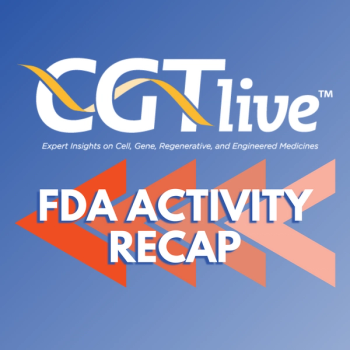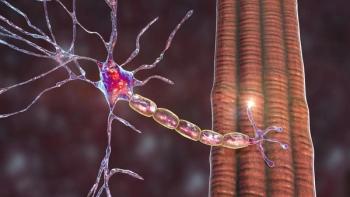
Beti-Cel Results in Impressive Activity in Pediatric Transfusion-Dependent Beta-Thalassemia
Treatment with the investigative gene cell therapy betibeglogene autotemcel led to durable transfusion independence in 87% of pediatric patients less than 18 years of age with transfusion-dependent beta-thalassemia with a median average hemoglobin of 11.3 g/dL.
Treatment with the investigative gene cell therapy betibeglogene autotemcel (beti-cel) led to durable transfusion independence in 87% of pediatric patients less than 18 years of age with transfusion-dependent beta-thalassemia (TDT) with a median average hemoglobin (Hb) of 11.3 g/dL, according to results from two phase 3 trials presented during the
The transfusion independence was maintained by having a dominant HbA787Q fraction in the blood, lead study author Mark C. Walters, MD, who is also the program director of Blood & Marrow Transplantation, program director of the Cord Blood Program, and medical director of the Jordan Family Center for BMT & Cellular Therapies Research, said during an oral presentation delivered on the data.
Moreover, the median weighted average Hb during transfusion independence was 10.1 g/dL in patients under the age of 12 years (n = 4) and 11.4 g/dL in patients between 12 years of age and 18 years (n = 9).
“Overall, the transfusion independence rate was very similar to the adults examined in the phase studies, which had been 83%,” said Walters. “Ineffective erythropoiesis was improved but not eliminated after beti-cel, and the treatment regimen with the gene therapy in pediatric patients less than 18 years of age had a tolerability profile that was consistent with the known effects of myeloablation with single-agent busulfan.”
Beti-cel was developed with the goal of establishing lifelong, functional adult Hb that permits transfusion independence without the need for a donor. To manufacture the product, stem cells are collected from the patient’s blood and then they are altered by a virus that brings working copies of the beta-globin gene into the cells.2 When the cells are returned to the patient, they are delivered via the bloodstream to the bone marrow; once there, they create healthy red blood cells that, in turn, produce beta-globin.
Currently, the gene therapy is under investigation in two phase 3 trials: HGB-207 (Northstar-2) and HGB-212 (Northstar-3). To be eligible for enrollment, patients had to be 50 years of age or younger and have TDT. Specifically, for HGB-207, patients had to have a non-β0/β0 genotype.
“These are individuals who have some endogenous Hb production, but not enough to avoid regular transfusions,” noted Walters. HGB-212 enrolled patients with the β0/β0 genotype, which is “more severe, and is characterized by having very little or no endogenous Hb production,” added Walters.
Once the safety and efficacy of the gene therapy was established, investigators expanded the research to include pediatric participation. To this end, 26 patients under the age of 18 years were enrolled to the phase 3 trials; they were broken into 2 subgroups: those less than 12 years of age (n = 14; 8 on HGB-207 and 6 on HGB-212) and those between 12 years and 18 years (n = 12; 6 on HGB-207 and 6 on HGB-212).
These patients proceeded to mobilization with granulocyte colony stimulating factor and plerixafor followed by apheresis. As part of the centralized manufacturing process, CD34-positive cells were selected, hematopoietic stem cells were transduced with BB305 lentiviral vector, and then the cells were cryopreserved.
Once shipped back to the transplant center, patients undergo myeloablative conditioning with single-agent busulfan and then the 24 patients were then infused with the gene therapy; 13 patients younger than 12 years received beti-cel (8 on HGB-207 and 5 on HGB-212), while 11 patients between 12 years and 18 years received the product (6 on HGB-207 and 5 on HGB-212).
The median follow-up following infusion was 15.5 months (range, 1.1-29.5). Patients were monitored for hematological recovery, including recovery in erythroid cells that have HbA787Q, the gene therapy Hb, according to Walters. “There’s a single amino acid substitution that permits this Hb to be measured directly after the drug product has been infused, and also the duration can be established,” noted Walters.
The follow-up for this study is 2 years, although patients are provided with the option to participate in long-term follow-up that will continue through 13 years.
At baseline, 46% of those in the cohort of patients less than 12 years (pediatric cohort) were male, as well as 64% of those in the cohort of patients between 12 years and 18 years (adolescent cohort). The median age at assent in the 2 cohorts was 8 years and 15 years, respectively. “Most of the patients had mild to moderate liver iron loading, but there was no cardiac iron loading,” noted Walters.
Additionally, 77% had the non-β0/β0 genotype in the pediatric cohort versus 64% of those in the adolescent cohort; 23% and 36% of patients, respectively, had the β0/β0 genotype. Only 1 patient had a splenectomy prior to trial enrollment and the majority of participants commenced red cell transfusions within their first year of life, added Walters.
The majority of patients had sufficient stem cells mobilized and collected after only 1 mobilization cycle (86%, pediatric; 83%, adolescent), while a smaller fraction required 2 cycles to collect enough cells for product manufacturing (14% and 17%, respectively). The vector copy number was 2.6 in the pediatric group and 3.3 in the adolescent group, and 70% versus 82%, respectively, had CD34-positive cells transduced. The estimated daily average area under the curve over the course of 4 days was 4164 μM*min and 4471 μM*min, respectively.
Regarding hematological recovery following infusion, no difference was observed between the 2 subgroups. Absolute neutrophil count of greater than 500 cells/μL or greater was observed at day 26, while platelets of over 20,000 were observed around day 50. “Natural killer cells were the first to recover, and CD4 cells took the longest to recover,” said Walters. “However, all the lymphocytes had recovered by 6 to 9 months post infusion.”
All patients in the adolescent subgroup achieved transfusion independence with beti-cel, with a duration of ongoing independence of 14.9 months (range, 12.2-21.6). Four of 6 patients in the pediatric subgroup achieved transfusion independence, with a duration of 15.2 months (range, 12.3-17.7).
Moreover, the majority of the total Hb was found to be comprised of HbA787Q in patients who achieved transfusion independence, particularly those in the adolescent group. “The younger group had somewhat lower levels of HbA787Q,” noted Walters.
Investigators also evaluated improvement in ineffective erythropoiesis in patients who achieved transfusion independence. “This was expressed as the level of the soluble transferrin receptor in the blood and absolute reticulocyte count,” explained Walters. “In most of the individuals there were improvements, although not all the patients moved back into the normal range.”
The safety profile of beti-cel was as expected following myeloablative busulfan, noted Walters. The most frequently reported non-hematologic grade 3 or higher toxicities included stomatitis (58%), febrile neutropenia (50%), and decreased appetite (21%). Serious adverse effects (AEs) included pyrexia (13%), febrile neutropenia (8%), and neutropenia (8%).
Toxicities determined to potentially be associated with the gene therapy were grade 1 tachycardia (n = 1) and grade 1 abdominal pain (n = 2) on the day of infusion and grade 3 thrombocytopenia (n = 1) following infusion, although this was not determined to be a serious case. Veno-occlusive liver disease was treated with defibrotide in 3 patients; although all cases resolved, 2 of these cases were determined to be serious.
No graft failure was observed, and all participants were alive at last follow-up, Walters concluded.
References
1. Walters MC, Kwiatkowski JL, Porter JB, et al. Safety and efficacy in pediatric patients with transfusion-dependent β-thalassemia (TDT) receiving betibeglogene autotemcel (beti-cel; LentiGlobin for β-thalassemia) gene therapy in the phase 3 HGB-207 (Northstar-2) and HGB-212 (Northstar-3) studies. Presented at: 2021 Transplantation & Cellular Therapy Meetings; February 8-12, 2021; Virtual. Abstract 122.
2. Zynteglo: betibeglogene autotemcel. bluebird bio. Accessed February 10, 2021.
Newsletter
Stay at the forefront of cutting-edge science with CGT—your direct line to expert insights, breakthrough data, and real-time coverage of the latest advancements in cell and gene therapy.











































